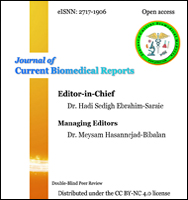The characterization of oxaliplatin-induced peripheral neuropathy using electromyography in gastrointestinal cancer patients
Abstract
Oxaliplatin-induced peripheral neuropathy (OIPN) is a common dose-dependent chemotherapy complication in gastrointestinal cancer (GIC). This side effect may restrict therapeutic dose elevation of oxaliplatin. Here, OIPN frequency and determinants of neuropathy appearance in oxaliplatin-treated GIC patients. A total of 102 GIC patients who underwent chemotherapy with fluorouracil, folinic acid and oxaliplatin (FOLFOX4) regimen participated in this longitudinal study. Electromyography (EMG) was accomplished for ulnar, radial, sural, peroneal nerves and superficial peroneal nerve (SPN) before, 3, and 6 months after treatment. National Cancer Institute-Common Toxicity Criteria V.3 and clinical version of the Total Neuropathy Score were used for the neuropathy diagnosis at six months after treatment onset. Of all entered patients, twelve people discontinued this study, and five patients passed away. About 85 patients remained three and six months after chemotherapy onset. Approximately 95% of patients three months after chemotherapy demonstrated OIPN manifestations. Finally, data for 81 patients having neuropathy were analyzed. Mean age of patient 64.0±10.9 years. There were about 3.7%, 30.9%, 63% grade III, II, I of neuropathy, respectively. Interestingly, a significant decrease in action potential (AP) amplitude of SPN, sural and radial nerves but not ulnar and peroneal was observed after treatment onset. However, only the ulnar nerve indicated a substantial deceleration of nerve conduction. Age, sex, weight, past medical diseases, smoking and acute neuropathy were not significantly associated with OIPN. The occurrence of OIPN is detectable by electrophysiological changes of SPN, radial, and sural nerves at three and six months after starting chemotherapy with the FOLFOX4 regimen.
Keywords
References
Dasari S, Tchounwou PB. Cisplatin in cancer therapy: molecular mechanisms of action. Eur J Pharmacol. 2014;740:364-78.
Johnstone TC, Suntharalingam K, Lippard SJ. The next generation of platinum drugs: targeted Pt (II) agents, nanoparticle delivery, and Pt (IV) prodrugs. Chem Rev. 2016;116(5):3436-86.
Köberle B, Schoch S. Platinum complexes in colorectal cancer and other solid tumors. Cancers. 2021;13(9):2073.
Haghighi S, Kasbkar H, Esmaeilpour K, Yasaei M. Oxaliplatin, 5fluorouracil and leucovorin (FOLFOX4) as first line chemotherapy in elderly patients with advanced gastric cancer. Asian Pac J Cancer Prev. 2016;17(7):3277-80.
Argyriou AA. Updates on oxaliplatin-induced peripheral neurotoxicity (OXAIPN). Toxics. 2015;3(2):187-97.
Zajączkowska R, Kocot-Kępska M, Leppert W, Wrzosek A, Mika J, Wordliczek J. Mechanisms of chemotherapy-induced peripheral neuropathy. Int J Mol Sci. 2019;20(6):1451.
Marshall TF, Zipp GP, Battaglia F, Moss R, Bryan S. Chemotherapy-induced-peripheral neuropathy, gait and fall risk in older adults following cancer treatment. J Cancer Res Pract. 2017;4(4):134-8.
Simão DAdS, Murad M, Martins C, Fernandes VC, Captein KM, Teixeira AL. Chemotherapy-induced peripheral neuropathy: review for clinical practice. Revista Dor. 2015;16(3):215-20.
Gordon-Williams R, Farquhar-Smith P. Recent advances in understanding chemotherapy-induced peripheral neuropathy. F1000Research. 2020;9.
Pasetto LM, D’Andrea MR, Rossi E, Monfardini S. Oxaliplatin-related neurotoxicity: how and why? Crit Rev Oncol Hematol. 2006;59(2):159-68.
Lazić A, Popović J, Paunesku T, Woloschak GE, Stevanović M. Insights into platinum-induced peripheral neuropathy–current perspective. Neural Regen Res.. 2020;15(9):1623.
Park SB, Lin CS, Krishnan AV, Goldstein D, Friedlander ML, Kiernan MC. Long-term neuropathy after oxaliplatin treatment: challenging the dictum of reversibility. Oncologist. 2011;16(5):708.
Argyriou AA, Polychronopoulos P, Iconomou G, Chroni E, Kalofonos HP. A review on oxaliplatin-induced peripheral nerve damage. Cancer Treat Rev. 2008;34(4):368-77.
Velasco R, Bruna J, Briani C, Argyriou AA, Cavaletti G, Alberti P, et al. Early predictors of oxaliplatin-induced cumulative neuropathy in colorectal cancer patients. J Neurol Neurosurg Psychiatry. 2014;85(4):392-8.
Shimizu T, Satoh T, Tamura K, Ozaki T, Okamoto I, Fukuoka M, et al. Oxaliplatin/fluorouracil/leucovorin (FOLFOX4 and modified FOLFOX6) in patients with refractory or advanced colorectal cancer: post-approval Japanese population experience. Int J Clin Oncol. 2007;12(3):218-23.
Kemeny N, Garay CA, Gurtler J, Hochster H, Kennedy P, Benson A, et al. Randomized multicenter phase II trial of bolus plus infusional fluorouracil/leucovorin compared with fluorouracil/leucovorin plus oxaliplatin as third-line treatment of patients with advanced colorectal cancer. J Clin Oncol. 2004;22(23):4753-61.
Tahrani AA, Altaf QA, Piya MK, Barnett AH. Peripheral and Autonomic Neuropathy in South Asians and White Caucasians with Type 2 Diabetes Mellitus: Possible Explanations for Epidemiological Differences. J Diabetes Res. 2017;2017:1273789.
Sempere-Bigorra M, Julián-Rochina I, Cauli O. Chemotherapy-induced neuropathy and diabetes: a scoping review. Curr Oncol. 2021;28(4):3124-38.
Dewanjee S, Das S, Das AK, Bhattacharjee N, Dihingia A, Dua TK, et al. Molecular mechanism of diabetic neuropathy and its pharmacotherapeutic targets. Eur J Pharmacol. 2018;833:472-523.
Hershman DL, Till C, Wright JD, Awad D, Ramsey SD, Barlow WE, et al. Comorbidities and Risk of Chemotherapy-Induced Peripheral Neuropathy Among Participants 65 Years or Older in Southwest Oncology Group Clinical Trials. J Clin Oncol. 2016;34(25):3014-22.
Khoshnoodi MA, Ebenezer GJ, Polydefkis M. Epidermal innervation as a tool to study human axonal regeneration and disease progression. Exp Neurol. 2017;287:358-64.
Tofthagen C, Donovan KA, Morgan MA, Shibata D, Yeh Y. Oxaliplatin-induced peripheral neuropathy’s effects on health-related quality of life of colorectal cancer survivors. Support Care Cancer. 2013;21(12):3307-13.
Mizrahi D, Park SB, Li T, Timmins HC, Trinh T, Au K, et al. Hemoglobin, Body Mass Index, and Age as Risk Factors for Paclitaxel-and Oxaliplatin-Induced Peripheral Neuropathy. JAMA Netw Open. 2021;4(2):e2036695-e.
Gilchrist LS, Tanner L. The pediatric-modified total neuropathy score: a reliable and valid measure of chemotherapy-induced peripheral neuropathy in children with non-CNS cancers. Support Care Cancer. 2013;21(3):847-56.
Sałat K. Chemotherapy-induced peripheral neuropathy—part 2: focus on the prevention of oxaliplatin-induced neurotoxicity. Pharmacol Rep. 2020;72(3):508-27.
DOI: https://doi.org/10.52547/JCBioR.3.2.77
Refbacks
- There are currently no refbacks.
Copyright (c) 2022 © The Author(s)

This work is licensed under a Creative Commons Attribution-NonCommercial 4.0 International License.













